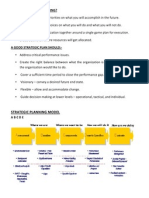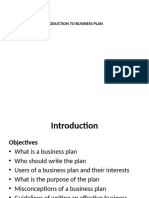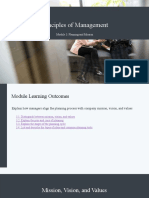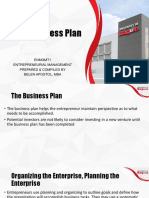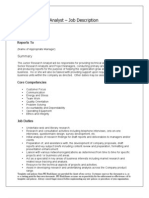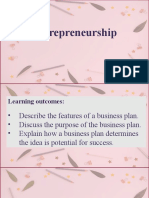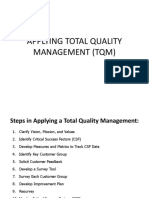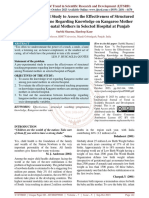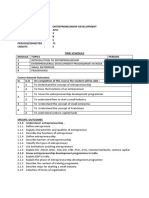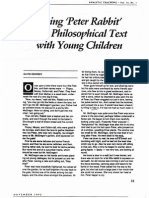0 ratings0% found this document useful (0 votes)
96 viewsThe Visioning Phase
The Visioning Phase
Uploaded by
Brilliananta Radix DewanaThe document outlines the key steps and activities in the visioning phase of business strategic planning. This includes understanding the current business situation, identifying the business vision and direction, assessing IT's alignment with business needs, and determining IT's role in supporting business objectives and strategies. Key activities involve reviewing business documentation, conducting stakeholder interviews, documenting the business analysis, and identifying how IT can help address business strengths, weaknesses, and opportunities.
Copyright:
© All Rights Reserved
Available Formats
Download as PPTX, PDF, TXT or read online from Scribd
The Visioning Phase
The Visioning Phase
Uploaded by
Brilliananta Radix Dewana0 ratings0% found this document useful (0 votes)
96 views24 pagesThe document outlines the key steps and activities in the visioning phase of business strategic planning. This includes understanding the current business situation, identifying the business vision and direction, assessing IT's alignment with business needs, and determining IT's role in supporting business objectives and strategies. Key activities involve reviewing business documentation, conducting stakeholder interviews, documenting the business analysis, and identifying how IT can help address business strengths, weaknesses, and opportunities.
Original Description:
Tebtabg Visioning Phase dalam ISSP
Copyright
© © All Rights Reserved
Available Formats
PPTX, PDF, TXT or read online from Scribd
Share this document
Did you find this document useful?
Is this content inappropriate?
The document outlines the key steps and activities in the visioning phase of business strategic planning. This includes understanding the current business situation, identifying the business vision and direction, assessing IT's alignment with business needs, and determining IT's role in supporting business objectives and strategies. Key activities involve reviewing business documentation, conducting stakeholder interviews, documenting the business analysis, and identifying how IT can help address business strengths, weaknesses, and opportunities.
Copyright:
© All Rights Reserved
Available Formats
Download as PPTX, PDF, TXT or read online from Scribd
Download as pptx, pdf, or txt
0 ratings0% found this document useful (0 votes)
96 views24 pagesThe Visioning Phase
The Visioning Phase
Uploaded by
Brilliananta Radix DewanaThe document outlines the key steps and activities in the visioning phase of business strategic planning. This includes understanding the current business situation, identifying the business vision and direction, assessing IT's alignment with business needs, and determining IT's role in supporting business objectives and strategies. Key activities involve reviewing business documentation, conducting stakeholder interviews, documenting the business analysis, and identifying how IT can help address business strengths, weaknesses, and opportunities.
Copyright:
© All Rights Reserved
Available Formats
Download as PPTX, PDF, TXT or read online from Scribd
Download as pptx, pdf, or txt
You are on page 1of 24
The Visioning Phase
• After organizing the planning project, the focus of this phase is to
obtain a thorough understanding of the business situation, direction,
and vision of how the business will operate in the future.
Initiate and Manage the Project
• Finalize Objectives, Goals, and Scope
1. Review the current business situation, business needs, business
process improvements, and future business direction.
2. Analyze the business situation and identify how the business affects
the IS situation and direction as well as how IS affects the business.
3. Review the current IS situation, including business applications,
information repositories, technical infrastructure, organization, and
processes.
4. Assess the current IS environment relative to business needs, including
its strengths, weaknesses, opportunities, and threats as it pertains to the
opportunities and threats faced by the business.
5. Compare the IS situation relative to the industry as a whole.
6. Identify short-term recommendations or quick hits that can be
implemented immediately.
7. Determine the high-level IS direction, including the vision, mission, key
objectives, and strategies.
8. Develop the specific direction for the business applications portfolio and
business process improvements.
9. Identify the required infrastructure necessary to support the business.
10. Identify the IS organizational impact and staff requirements.
11. Determine the IS processes requiring improvement.
12. Formulate the implementation plan, including specific projects,
priorities, and the roadmap.
13. Identify an estimate of costs and business benefits.
14. Develop the communication plan, business liaisons, and governance
necessary to implement planning as an ongoing process.
• Identify Resources, Roles, and Responsibilities; Interview
Participants
• At the beginning of the planning effort, evaluate whether the
organization has the proper resources to complete the IS strategic
planning process successfully and in a timely manner.
• Document the specific roles and responsibilities of everyone involved
in the planning effort. Identify the roles of the business and IS as well
as the consultant.
• Document the responsibilities of the various groups involved in the
planning process, and identify their level of authority and decision-
making responsibility.
• Identify individuals to interview or converse with as part of the planning process.
• In a typical organization, plan to interview the following individuals:
1. The entire executive management team.
2. The level of management immediately below the executives.
3. A few key individuals in the business organization: This could be a master
scheduler, someone in shipping or customer service. Typically, these are the
“go to” people when there are questions in the business, and they have usually
been with the organization for numerous years. It can also be helpful to
interview a few individuals new to the organization because they may have an
interesting perspective.
4. The members of the IS steering committee.
5. The IS management team.
6. A few key individuals within the IS organization
• Confirm Deliverables and Work Plan
• Review the planning methodology to develop the table of contents
for your strategic plan
• Draft Deliverable Templates
• Right at the beginning of the planning process is an excellent time to
draft the deliverable documents. The documents will become a
repository for the planning information as it is developed. Then it can
be reviewed by individuals at each milestone and can be updated
through an iterative process.
• Announce the Project; Conduct Project Orientation
• Next, announce the strategic planning project to those involved in the
planning process and interviews.
• Establish Ongoing Project Governance, Communications, and Status
Report
• Determine who to keep abreast of the planning project and how
often they should receive updates.
Review and Confirm Project Plan
• Understand the Business Situation and Vision
• Review Business Documentation
• Business plan, planning material, brochures, sales and marketing literature,
and product brochures, etc.
• Develop Business Interview Questions, Surveys, and Workshop Structure
• Surveys can be helpful to get quantitative data. If you have properly
established an internal network, most of this work is little more than a
formality, making sure everyone knows what each has already explained
informally.
• Schedule Conduct Document Review and Confirm
Document and Confirm the Business Analysis
• Document Current Business Description, Vision, Values, Goals,
Strategies, Direction, Operating Vision, Business Projects, and
Initiatives
• Document Industry Business Trends, Business, and Customer
Requirements
• Document Business Strengths, Weaknesses, Opportunities, and
Threats
• Document the strengths, weaknesses, opportunities, and threats
(SWOT) of the business. This is important because these aspects may
have an impact on IS, and there may be opportunities for IS to
improve the weaknesses or capitalize on the strengths.
• Document Business Impact on IS
• If a company has a business strategy of globalization, IS should be
able to handle global requirements.
• If a company has a strategy of acquisitions and divestitures, systems
should be scalable to meet the changing business needs.
• If a business is weak in project management and execution, IS can
utilize project management methodologies and techniques to help
the organization improve.
• IS can assist the business in many different ways. Here are some
examples:
• Provide unique product and service features.
• Reduce product development time.
• Allow the delivery of customized services.
• Open new channels and market niches.
• Produce higher quality results.
• Fill product positioning gaps.
• Block channel access.
• Increase buyer switching costs
• IS and the Business Strategies
• Provide superior product availability worldwide
• Deliver outstanding customer service and support
• Rapidly pursue targeted growth opportunities
• Create high-value, differentiated products for growth.
• Be the best cost producer
• Manage the business globally
• Maintain an environment where people want to work
• IS and the Business Goals
• Achieve financial targets and credibility
• Merge to a common architecture
• Transition selling and servicing organizations to achieve competitive
advantage
• Develop strong third-party relationships
• Develop a strong corporate identity
You might also like
- Emmy Van Deurzen - Martin Adams - Skills in Existential Counselling & Psychotherapy-Sage (2016)Document249 pagesEmmy Van Deurzen - Martin Adams - Skills in Existential Counselling & Psychotherapy-Sage (2016)readalldial100% (5)
- FOREX101 Day2Document122 pagesFOREX101 Day2chris scott100% (2)
- Manage Installation WorkDocument58 pagesManage Installation Workshimels chekoleNo ratings yet
- Lesson 1 Business EnvironmentDocument11 pagesLesson 1 Business EnvironmentHimanshu TalwarNo ratings yet
- Lesson 4 Business PlanningDocument34 pagesLesson 4 Business PlanningKelvin MshalieNo ratings yet
- Feasibility PP TDocument26 pagesFeasibility PP TAriadne Ramos CorderoNo ratings yet
- Writing A Business Plan: Pinky SharmaDocument34 pagesWriting A Business Plan: Pinky SharmavikramNo ratings yet
- Entrep: Business PlanningDocument38 pagesEntrep: Business PlanningJeremiah DumalagNo ratings yet
- DPPM Business Plan-2Document38 pagesDPPM Business Plan-2Edgar MugaruraNo ratings yet
- Abdullah Afzal MBA1.5Document10 pagesAbdullah Afzal MBA1.5Abdullah AfzalNo ratings yet
- Business Plan ContentDocument5 pagesBusiness Plan ContentRhislee PabrigaNo ratings yet
- BTW Feasibility StudyDocument24 pagesBTW Feasibility StudyRichelle Lynne CuNo ratings yet
- This Is The Job Description of A CEO Managing DirectorDocument5 pagesThis Is The Job Description of A CEO Managing DirectorHarthwell CapistranoNo ratings yet
- What Is Business StrategyDocument19 pagesWhat Is Business Strategydasboot69100% (2)
- Putting It All Together Holistically Business Plan (1)Document23 pagesPutting It All Together Holistically Business Plan (1)amaduddinhhcNo ratings yet
- Entrep RevieweDocument4 pagesEntrep Reviewewilson dela cruzNo ratings yet
- Yuma Regional Medical Center Business Plan Template: I. Executive SummaryDocument4 pagesYuma Regional Medical Center Business Plan Template: I. Executive SummaryMaria YounusNo ratings yet
- Strategy DevelopmentDocument132 pagesStrategy DevelopmentNovalonNo ratings yet
- Strategic PlanningDocument7 pagesStrategic PlanningSmriti KushwahaNo ratings yet
- Lecture 5.business PlanningDocument32 pagesLecture 5.business Planningkyalojohn405No ratings yet
- Unit - 1Document22 pagesUnit - 1Swayamvar vermaNo ratings yet
- Daniyal AssignmentDocument9 pagesDaniyal AssignmentWazeeer AhmadNo ratings yet
- Business Plan IntroDocument97 pagesBusiness Plan Introvscolegit shoppeNo ratings yet
- Chap 3Document32 pagesChap 3HaileNo ratings yet
- Unit 5Document23 pagesUnit 5Niban KhadkaNo ratings yet
- Entrepreneurship For Kids, Canvas Business PlanDocument9 pagesEntrepreneurship For Kids, Canvas Business PlanGustavo masNo ratings yet
- Week5 ADocument23 pagesWeek5 AArslan RehmanNo ratings yet
- Topic 02-1Document31 pagesTopic 02-1faumakassimNo ratings yet
- Lesson 2.2 Business PlanningDocument10 pagesLesson 2.2 Business PlanningBNo ratings yet
- Performance ConsultingDocument21 pagesPerformance ConsultingMJaved KalburgiNo ratings yet
- Performance Consulting: by Nethravathi.HDocument21 pagesPerformance Consulting: by Nethravathi.HMJaved Kalburgi100% (1)
- Principles of Management: Module 3: Planning and MissionDocument32 pagesPrinciples of Management: Module 3: Planning and Missionnaman khan satnaNo ratings yet
- New Venture Unit 4Document36 pagesNew Venture Unit 4Priyanka SinghalNo ratings yet
- Lec-8 Business Plan - Linear VS CircularDocument33 pagesLec-8 Business Plan - Linear VS CircularShahwaiz MunirNo ratings yet
- Feasibility StudyDocument24 pagesFeasibility StudyCharisse Leonardo100% (1)
- Chapter 8 The Business PlanDocument25 pagesChapter 8 The Business PlanKATE ANDRE MENDOZANo ratings yet
- Analysts Role in The BA ModelDocument35 pagesAnalysts Role in The BA ModelAbhishek DubeyNo ratings yet
- Entrepreneurship Session 2 PptDocument69 pagesEntrepreneurship Session 2 PptMebo JosephNo ratings yet
- MODULE 7 BESR Ways To Improve BusinessDocument3 pagesMODULE 7 BESR Ways To Improve Businessharrypot0923No ratings yet
- SBA Note 1Document2 pagesSBA Note 1barabida3No ratings yet
- Entrepreneurship - Chapter - 4Document46 pagesEntrepreneurship - Chapter - 4esubalew almawNo ratings yet
- Strategic ManagementDocument71 pagesStrategic ManagementHabtamu mamoNo ratings yet
- Case Study Method: Dr. Rana Singh MBA (Gold Medalist), Ph. D. 98 11 828 987Document33 pagesCase Study Method: Dr. Rana Singh MBA (Gold Medalist), Ph. D. 98 11 828 987Belur BaxiNo ratings yet
- Module 10 Business Plan DevelopmentDocument27 pagesModule 10 Business Plan DevelopmentHeidi100% (1)
- Introduction To Management Part 3Document50 pagesIntroduction To Management Part 3Navruz KhakimovNo ratings yet
- Bus - Ethics - q3 - Mod7 - Ways To Improve Business Practices Guided by The Philosophies Belief System or Filipino Values - Final 1Document3 pagesBus - Ethics - q3 - Mod7 - Ways To Improve Business Practices Guided by The Philosophies Belief System or Filipino Values - Final 1Arianne Mae LloreraNo ratings yet
- Entrepreneur and Business Planning The Entrepreneurial and Intrapreneurial MindDocument20 pagesEntrepreneur and Business Planning The Entrepreneurial and Intrapreneurial MindAmara ArshadNo ratings yet
- CHAPTER 3 Planning, Organizing and Managing A Small BusinessDocument37 pagesCHAPTER 3 Planning, Organizing and Managing A Small BusinessnaimuddinnorulhakNo ratings yet
- It Entrepreneurship: (SCK3463/ SCD4763)Document27 pagesIt Entrepreneurship: (SCK3463/ SCD4763)NurZul HealMeNo ratings yet
- Business PlanDocument4 pagesBusiness PlanSpectre 7575No ratings yet
- Lecture Slide 1Document43 pagesLecture Slide 1lodewe2148No ratings yet
- Feasibility Studies and Business PlansDocument21 pagesFeasibility Studies and Business PlansSanya MohindraNo ratings yet
- Junior Research Analyst - 20110704Document10 pagesJunior Research Analyst - 20110704Rebel_DragonNo ratings yet
- PPA 502 - Program EvaluationDocument47 pagesPPA 502 - Program EvaluationmaanaNo ratings yet
- ENTREP Introduction-2Document22 pagesENTREP Introduction-2水流MizukiNo ratings yet
- Entrepreneurship Development: Topic Business Plan - IntroductionDocument11 pagesEntrepreneurship Development: Topic Business Plan - IntroductionDr.Sree Lakshmi KNo ratings yet
- 1.0 Strategic Planning PDFDocument29 pages1.0 Strategic Planning PDFSamuelRichardNo ratings yet
- Applying Total Quality Management (TQM)Document15 pagesApplying Total Quality Management (TQM)jeffersondomagasNo ratings yet
- International Business Strategy A Complete Guide - 2020 EditionFrom EverandInternational Business Strategy A Complete Guide - 2020 EditionNo ratings yet
- Constitutional Law - Ii: Prerequisite: None Course Code: SLL 2708 Credits: 04 Course ObjectivesDocument3 pagesConstitutional Law - Ii: Prerequisite: None Course Code: SLL 2708 Credits: 04 Course ObjectivesSuditi TandonNo ratings yet
- BUET SyllabusDocument37 pagesBUET SyllabusNirob MahmudNo ratings yet
- Kiswahili s.1 Notes 2020Document28 pagesKiswahili s.1 Notes 2020denniswanjala002No ratings yet
- Lab 5 IDS SNORTDocument10 pagesLab 5 IDS SNORTMary Amirtha Sagayee. GNo ratings yet
- What Can You Say About The Conditions of The Cigarreras in Manila?Document2 pagesWhat Can You Say About The Conditions of The Cigarreras in Manila?JULIUS BORDON100% (2)
- GRAND TOTAL (In Words) :rupees Ten Thousand Eight Hundred Thirteen OnlyDocument3 pagesGRAND TOTAL (In Words) :rupees Ten Thousand Eight Hundred Thirteen OnlyKamal JoshiNo ratings yet
- INFP - 6 Career PathsDocument5 pagesINFP - 6 Career PathsAnthony Farquhar WuNo ratings yet
- The Limits of Quantum Computers PDFDocument8 pagesThe Limits of Quantum Computers PDFkebarclaNo ratings yet
- Bolletta API Download v2Document6 pagesBolletta API Download v2davduranNo ratings yet
- A Pre Experimental Study To Assess The Effectiveness of Structured Teaching Programme Regarding Knowledge On Kangaroo Mother Care Among Post Natal Mothers in Selected Hospital at PunjabDocument3 pagesA Pre Experimental Study To Assess The Effectiveness of Structured Teaching Programme Regarding Knowledge On Kangaroo Mother Care Among Post Natal Mothers in Selected Hospital at PunjabEditor IJTSRDNo ratings yet
- Rimbaud, Father of Surrealism. BaysDocument8 pagesRimbaud, Father of Surrealism. BaysAndrea M. Guardia H.No ratings yet
- Supporting Second Language Writing Using Multimodal FeedbackDocument17 pagesSupporting Second Language Writing Using Multimodal FeedbackSpiros MoustakasNo ratings yet
- EntrepreneurshipDocument2 pagesEntrepreneurshipjaijohnkNo ratings yet
- Chemistry Project STD XiiDocument2 pagesChemistry Project STD Xiibone fire100% (1)
- PZO90125 (Ruins of Azlant) Tower of The DrownedDocument100 pagesPZO90125 (Ruins of Azlant) Tower of The Drownedn3512535No ratings yet
- Responding To The EnvironmentDocument89 pagesResponding To The Environmentlazgee828No ratings yet
- NMR HandoutDocument23 pagesNMR HandoutVirendra Singh RajputNo ratings yet
- My Project SlidesDocument23 pagesMy Project SlidesAnonymous XrXVPTrNo ratings yet
- PTSD in Children: Critical Thinking QuestionsDocument3 pagesPTSD in Children: Critical Thinking QuestionsAOsmani 39920No ratings yet
- Cake Masters 2012'05Document64 pagesCake Masters 2012'05susan100% (2)
- Debate Flash CardsDocument6 pagesDebate Flash CardsVeronicaGelfgren100% (2)
- Using Peter Rabbit' As A Philosophical Text With Young ChildrenDocument10 pagesUsing Peter Rabbit' As A Philosophical Text With Young ChildrenDavid KennedyNo ratings yet
- Employment Law Test 2Document2 pagesEmployment Law Test 2fabiolabeukesNo ratings yet
- 111 Critical ApproachesDocument33 pages111 Critical ApproacheshamidNo ratings yet
- LESSON PLAN ON GNM Communication & SkillsDocument6 pagesLESSON PLAN ON GNM Communication & SkillsPandya TupuNo ratings yet
- F MyDocument20 pagesF Myjoao.matheus.torres.soutoNo ratings yet
- Judicial Affidavit RapeDocument5 pagesJudicial Affidavit RapeJasOn EvangelistaNo ratings yet


















